| |
|
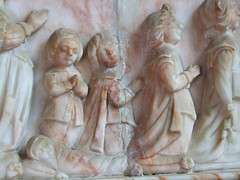 |
|
That poor Simon
Jenkins. Not a day can go past without
someone questioning the choices in his
book England's Thousand Best
Churches. Here in Suffolk, he missed
three that are clearly county top twenty
material: the amazing St Andrew at
Westhall, grand St Mary at Redgrave, and
here, St Margaret at Sotterley. Westhall
has been described as Suffolk's best-kept
secret, but in many ways Sotterley is
more secretive, and is certainly less
well-known. Indeed, some people would be
surprised to learn that it has more
figure brasses than any other church in
Suffolk, not to mention much else of
interest.
But first, you must get there. Sotterley
is easily found on an Ordnance Survey map
because it looks so darned curious. The
roads between Beccles and Southwold
swerve widely to avoid it, and it is
marked as a large, round private park,
about three miles in circumference.
Houses scattered around the perimeter
form the village, but the parkland itself
is all open fields, lawns and a long
ornamental lake. Near the centre of the
parkland is the great house, and beside
it the church of St Margaret. |
However, when you get here
you'll find that it is only a private driveway
which reaches the house from near the turn off to
Willingham, and it doesn't give access to the
church except for services, and no public
footpath crosses the park. In addition, you
cannot see the church from any public road, so
unless you have the map or inside information,
you won't even know it is there.
Just to the north of the
private drive entrance, there is a gap in the
hedgerow and a wooden stile. This is the start of
a walk which is almost a mile long; it will take
you across the fields and to the church. As I
said before, it is not a public footpath; rather,
it is an access path across what remains private
property. So you climb the stile, and set off
across the fields. In summer and autumn you will
find yourself walking through cows, but they are
harmless enough. The way is marked by large OS
church symbols on white boards attached to trees,
but they can get hidden by growth in springtime.
After about a third of a mile, the path diverges
rightwards down to a rickety wooden bridge across
the infant River Blyth, and then into the field
beyond.
The path then skirts the righthand edge of a
field for about a third of a mile (don't be
tempted by the signs to hop the fence; you'll
only need to come back into the field to cross
the next river) and takes you round to another
wooden bridge with sheep gates. Here, you can see
the church for the first time. Across the next
field, you enter the churchyard in its north-west
corner.
St Margaret is a long, low
building, with a tower that is at once simple and
elegant. The lower stage is probably Norman, and
the great rebuilding here happened unusually
early for Suffolk, certainly before the Black
Death. The 18th century Hall sits immediately to
the south, separated from the graveyard only by a
low wall. St Margaret is a classic example of an
estate church, one of few in Suffolk that retains
its relationship with the Big House. The estate
was the home of the Playters family until the
middle of the 18th century, and it is their name
you'll find all over the inside of the church.
Earlier, it had been the seat of the Soterleys,
and later it became the home of the Barne family,
who we have already met at Dunwich. The families
have been good guardians, because the building
not only retains eight figure brasses and
numerous other inscriptions, but some fascinating
medieval glass, wonderful roof corbels, a good
roodscreen (albeit completely repainted) and
Suffolk's loveliest monument. All in all, it is a
shame that Simon Jenkins missed it.
So, pausing to note the unusually early 1678 tomb
to Rector James Bell to the south of the chancel,
you step through the little porch into the cool
of the church. Although much of the fabric of the
building is original, there was a substantial
late 19th century restoration here, which filled
the nave with middle-brow furnishings. The font
is a good example of the typical 15th century
East Anglian design, and there are four
hatchments above the war memorial. This end of
the church is no more dramatic than many other
local churches, but don't miss the banner stave
locker set in the wall to the west of the south
door. These tall alcoves were supposedly designed
for holding processional crosses and the like;
there are about a dozen of them, but they are
only found in the churches of the north-east of
the county. What did people do elsewhere?
As you walk east, the building becomes more
interesting, and once you are in the chancel it
is fascinating. Here, the Soterleys and the
Playters remembered themselves in brass and
stone. Some of the brasses are set in the
sanctuary, others in the centre of the chancel
floor. There are six figure brasses in total.
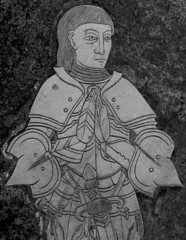 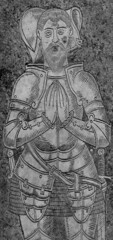 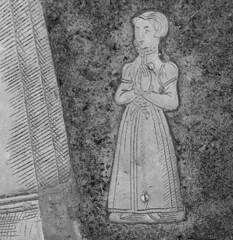 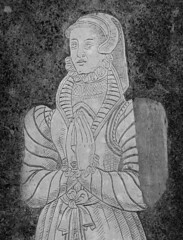 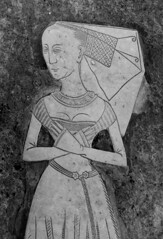
All the brasses except that
on the tomb chest are covered by removable
matting, but it would be easy to miss them if you
did not know that they were there and did not
think to investigate. The same cannot be said for
the grand 17th century monument to Sir Thomas
Playters to the north of the sanctuary. It is
probably the most famous in Suffolk, and I think
it is the best. It was actually installed during
the Commonwealth in 1658, and Mortlock says that
the sculptor was Edward Marshall, who would
become sculptor to the crown at the Restoration
of Charles II in 1660.
Thomas Playters had died in 1638, and a brass
inscription in the chancel floor remembers him.
Here on the wall he is shown in the middle, with
his two wives on either side, both conveniently
called Anne. By Anne I he had two sons and two
daughters, but Anne II bore him a jaw-dropping
eighteen children. What makes the memorial so
remarkable, though, is the way the 22 children
are shown as weepers on the panel beneath.
Instead of the usual uniform kneeling figures
united in sorrow, each child is given its
individual character - in short, they all look
like different people, and are doing different
things. Some kneel in formal prayer, but others
are distracted; one turns round to chat to her
sister, while others gaze out at the viewer. One
poor little mite is wrapped in a blanket right
near the middle of the panorama. Some sources
describe this as a 'chrysom cloth', but of course
this cannot be right, because in the middle of
the 17th century such a Catholic sentiment would
be quite beyond the pale.

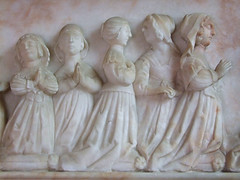 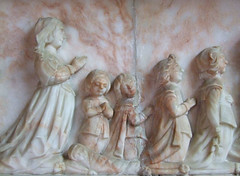 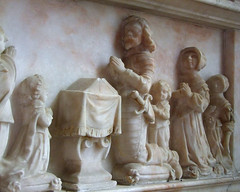
It has to be said that Sir
Thomas's first family look more equal to the task
of formal mourning than the second. The monument
is rather hard to photograph, because the altar
screen stands in front of part of it. Another
fine Playters memorial is on the opposite side of
the sanctuary; part of the inscription is in
Greek, which always looks unfamiliar in an
English church.
Stepping back through the screen, the nave is
lighter than the chancel because of the two large
windows either side. Presumably, they were
intended to light the rood, but the one to the
north is set in the closed entrance to a
now-vanished transept chapel. Panels of medieval
and continental glass have been set in them,
surrounded by clear lozenges. Among them are a
Lamb of God, Christ in Majesty, a pilgrim who may
be St James, and a later Flemish Holy Trinity;
God the Father sits on a throne with the
crucified Christ on his lap, while a dove perches
on his shoulder. There is some other good glass
in the west window beneath the tower; a king with
a sword walks towards a beckoning bishop, rather
as if they were on their way to a chess match. I
wondered if the person who set them there had
imagined them to be St Paul and St Peter.
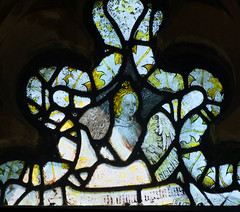 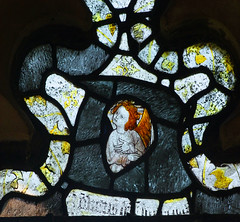
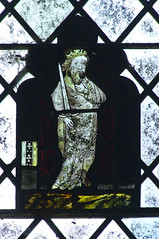 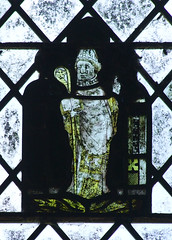 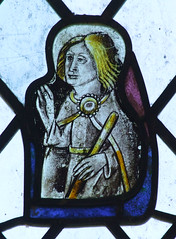
Perhaps the best medieval
glass in the church is behind the altar screen in
the east window, so you may have missed it.
Beneath the restrained Victorian saints is a
reset 1470s portrait of Sir William Playters,
with his sons grouped behind him, looking as if
he is on holiday from the north aisle at Long
Melford. The gorgeous reredos beneath it is by
Sir Charles Nicholson, and is redolent of the
Anglican piety of the first quarter of the 20th
Century.
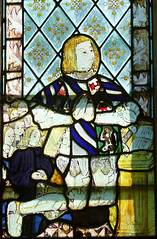 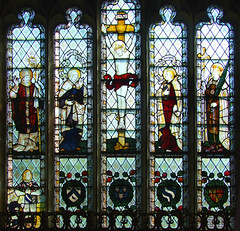
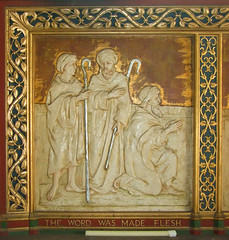 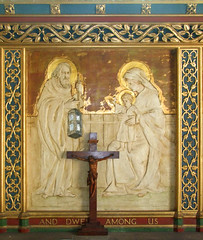 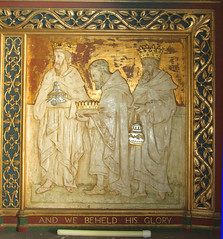
The screen,
then. It is elegant and pretty in that way that
only smaller screens are, but it has been heavily
restored and repainted. This incurs the wrath of
the likes of Cautley, but we have no way of
knowing what was lost and in an case it is done
here rather well. The original doors are in
place, which is very unusual in this part of the
county, and the cusping at the top was thought
original by Mortlock. The Saints are in an early
20th century style, and are mostly easily
identifiable from their symbols. I thought the
best were St Batholomew, St James, and St John
the Evangelist.
You may notice as you wander about this building
the wooden memorial crosses to the two Barne sons
who were killed in the first world war. These
poignant, amateur memorials marked the graves of
troops killed in France, and were later sent
home. In the 1920s there were hundreds of them,
thousands, scattered through the parish churches
of England. Gradually, they were replaced by more
permanent memorials, and many were removed by
families or destroyed. A few survive, here and
there - there are six at Leavenheath and seven at
Melton. In fact, there are fine memorials above
the crosses, and the boys' names are also on the
parish memorial on the north wall. But the
crosses have survived.
And so has
something else even more poignant. This
is the original roll of honour, now on
the wall behind glass under the tower, on
which the names of the local dead were
written as the awful news came in. It is
horrifying to see so many young people's
names in such a tiny parish as this;
there are fifteen of them, including four
in just twenty days in September 1918. At
Hitcham a few days earlier I had learned
how, of the 42 men of that parish who
never returned from the mud and blood of
Flanders, only 28 had made it on to the
war memorial. A contemporary record, like
the roll of honour here, probably gives a
truer picture of the way the carnage
devastated rural communities, and changed
England forever.
I stepped outside and breathed the spring
air, looking across at the grand facade
of Sotterley Hall. In the early 19th
century the residents of the Hall wearied
of seeing the funeral processions of the
poor passing their drawing room windows,
and provided a new burial ground down at
the crossroads in the village. This
included a pretty red-brick mortuary chapel, which survives today. |
|
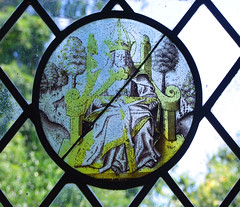 |
|
|
|

